Gibson only made 98 Flying Vs in the 1950s – which makes this ’58 Flying V one of the rarest electric guitars to come out of the company’s factory
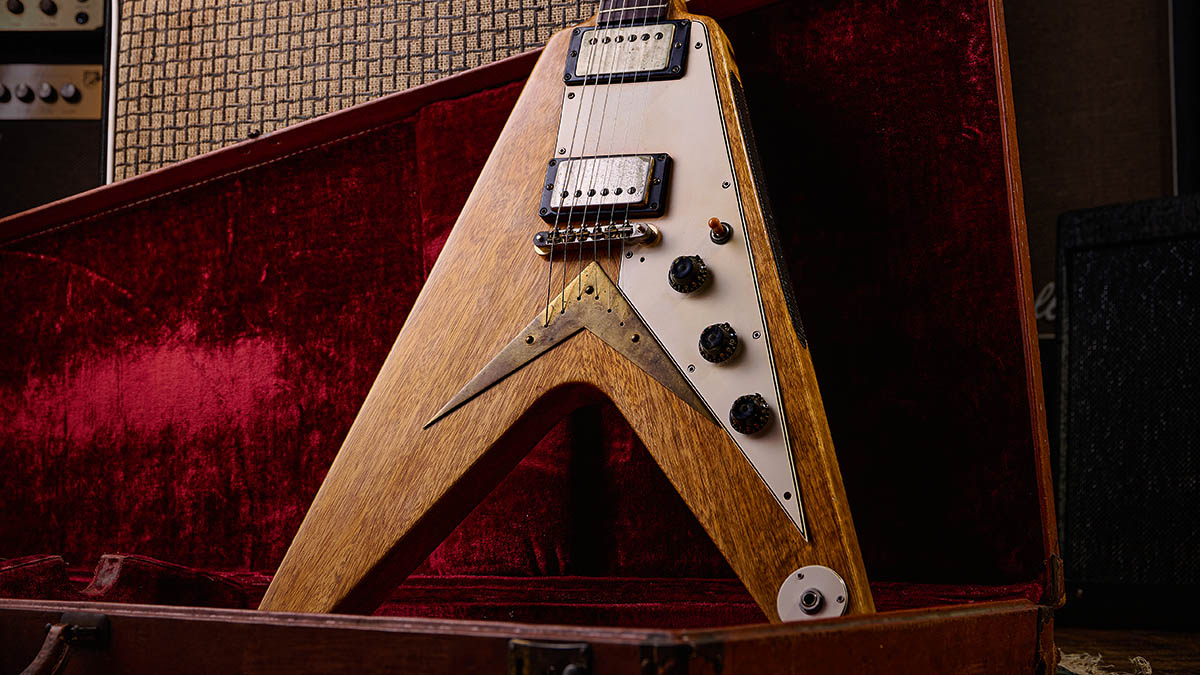
Researching and authenticating guitars is clearly an enjoyable part of the job for Gardiner Houlgate’s guitars and musical instruments auctioneer, Luke Hobbs, and it’s clear that he got his teeth into a certain 1958 Flying V.
“The guitar was purchased by the vendor in late 1990,” he tells us, “and it had been imported from America to the UK in 1989 by a collector called Julian Marsh. He used to travel to the US with vintage Vox and Marshall amps and trade them for American guitars. This Flying V had come into a shop called the American Guitar Center in Washington [DC] that was run by a guy called John Sprung, and Julian got the guitar from him, along with some of the guitar’s history.
“It was originally sold by a shop called the Thomas Piano Company in Newport News, Virginia,” he continues. “Washington is sort of the closest big city, so the assumption is that it only travelled a short distance, but whether John Sprung got it from the original owner, we don’t know.
“When he got the guitar back to the UK, Julian sold it on to Jed Johnson, another collector, but he only kept it for about six months. He contacted our seller and offered him the choice of two Flying Vs, the 1958 and a 1959 that also had some issues. After trying both, he chose the 1958 because he thought it sounded a lot better and it had its original case. But most of all he preferred the smaller neck profile.”
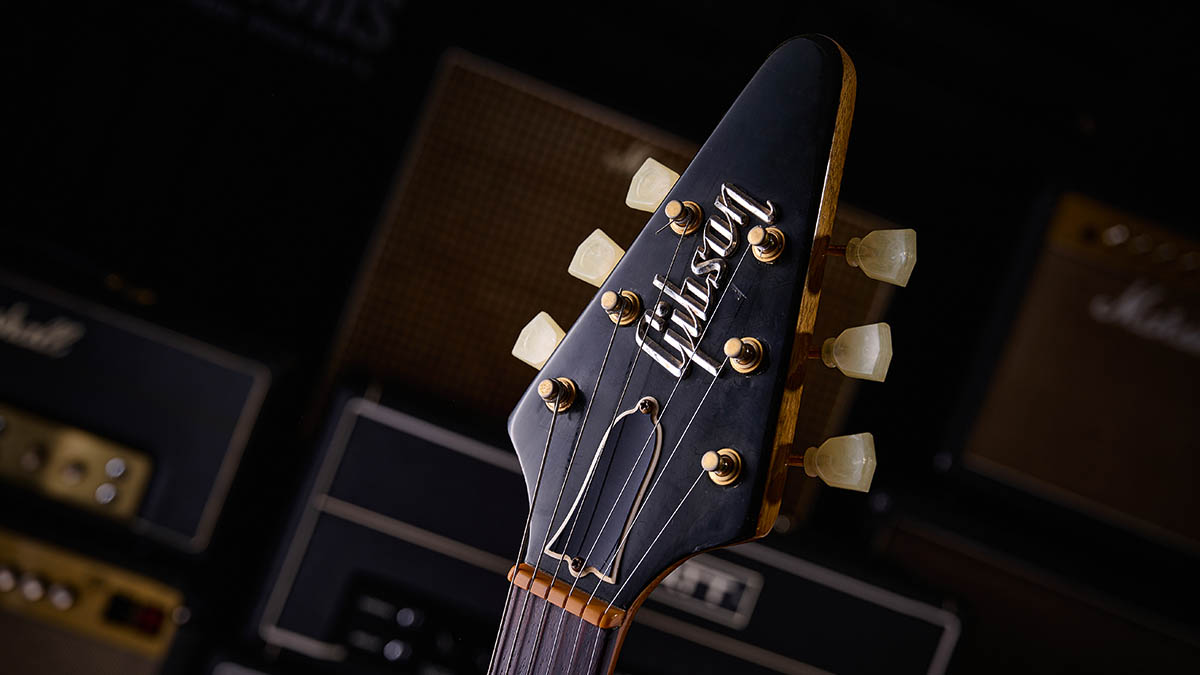
Neck & Numbers
Mention of the neck leads us onto the most significant modification that has been made to the guitar. A previous owner decided to have the fretboard width reduced, and it now measures 40mm at the nut rather than the 42.8mm typical on Gibsons from this era. We’ll refrain from commenting on the wisdom of this decision, but we can report that whoever performed the work had some skills.
Since there is no damage to the body and the skinny 1958 frets appear to be original, we’d suggest the fretboard may have been removed and ground along the edges. Once reattached, the neck shoulders were then recontoured to meet the narrower fretboard edges.
“We’re assuming it was done in the care of whoever had it before John Sprung,” Luke suggests. “The guitar has also been refinished twice at least, and was once green judging by traces of lacquer remaining in the control cavities.
All the latest guitar news, interviews, lessons, reviews, deals and more, direct to your inbox!
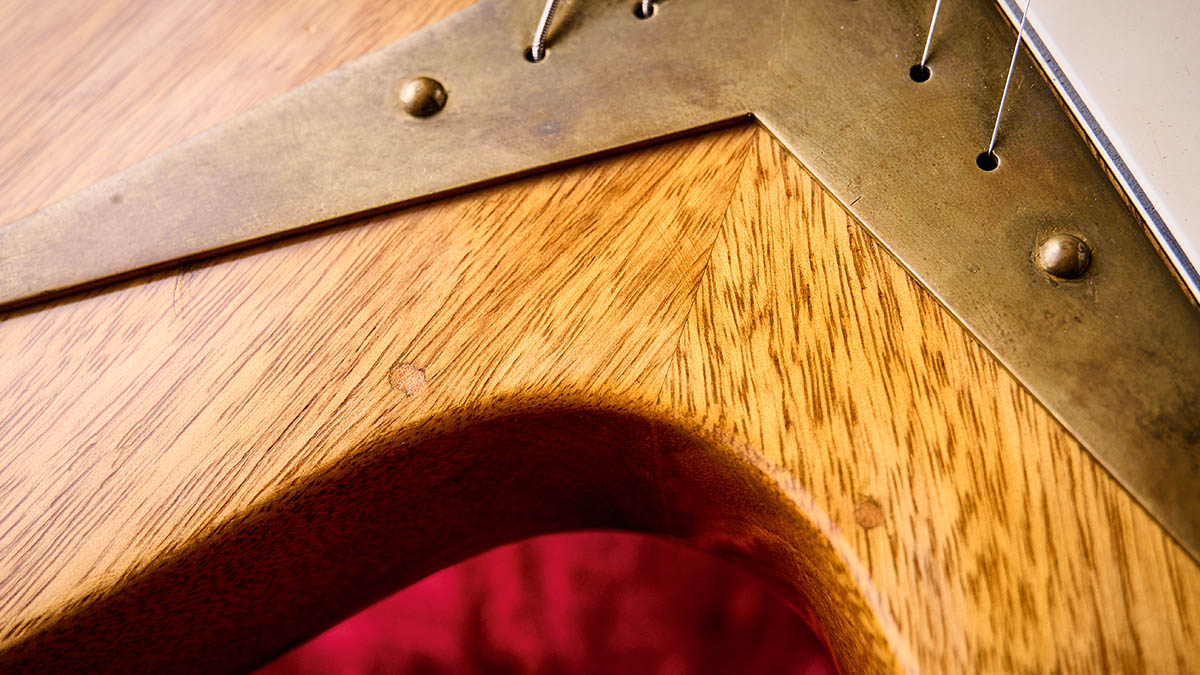
“It also has a repair on the headstock, where one ‘wing’ was reglued using dowels. The factory serial number stamp has gone, but we believe they put the original ‘8-2685’ serial number back on when the guitar was resprayed with clear lacquer. The font is wrong, but the number matches the 15th Flying V produced according to Gibson’s ledger list, which also shows that the guitar was shipped to the Thomas Piano Company.
“We know that the current serial number was on the guitar when Julian Marsh bought it, and the number can be seen in photos taken in 1991 for Tony Bacon’s The Ultimate Guitar Book. Gibson’s ledger wasn’t made public until The Flying V [: The Illustrated History Of This Modernistic Guitar by Larry Meiners] was published in 2001, so the serial number is either correct or an impossibly lucky guess.”
Hardware & Electronics
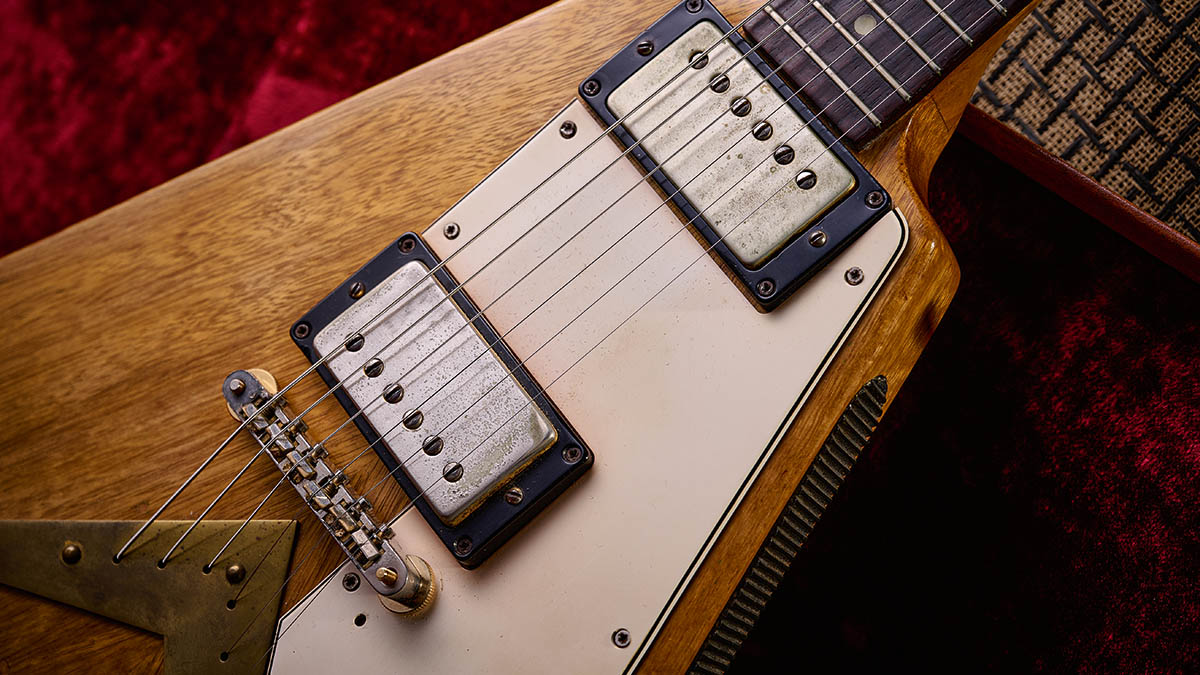
All the original hardware and electronics are present. The potentiometers date to 1958 and although the capacitor isn’t a type typically seen on late-1950s Gibsons, an identical capacitor can be seen in a YouTube video where Joe Bonamassa dismantles a 1958 Flying V.
Very little of the gold plating survives on the top of the PAF covers, but it can still be seen on the sides where the plastic rings have provided protection. All the tulip tuner buttons were shrinking when the current owner bought the guitar and they have since disintegrated. The debris was carefully bagged up and will be included in the sale. Fortunately, however, the switch tip and knobs have fared better.

Extreme yellowing of the nut suggests that it’s made of bone, so it’s likely the nylon original was discarded when the fretboard was modified. We photographed the guitar with its original but rattly ABR-1 bridge, but the owner’s repro was fitted when we tried the guitar.
The threaded post on the treble side protrudes above the bridge. And while Luke has both the original posts, one is slightly shorter and he believes part of it has snapped off inside the body. Judging by three plugged holes in the top, and the extra one in the pickguard, a horseshoe Bigsby vibrato was probably installed at some point.
Classic Case
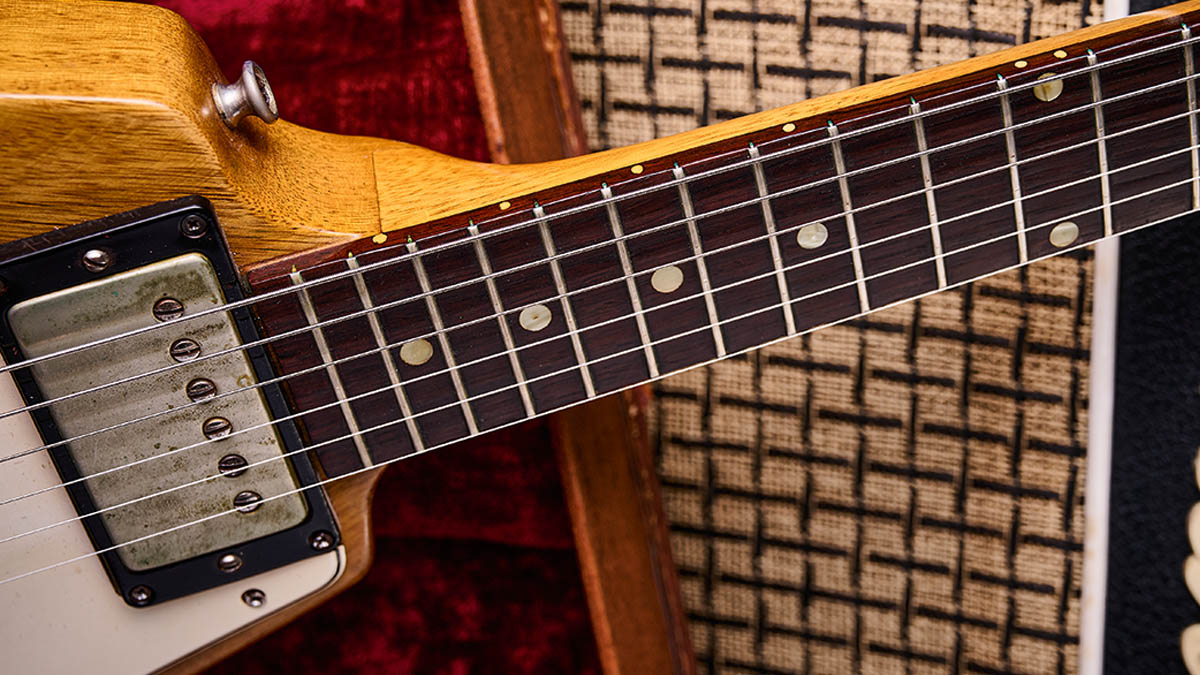
As scarce as ’50s Vs are, the cases are even harder to find and this example comes with the rarest case of all, as Luke explains: “The lining is oxblood, but everywhere I’ve looked ’58 and ’59 Vs would have pink-lined cases. The reference books don’t actually state the colour of the lining, but interestingly the Vintage Guitar Price Guide mentions the oxblood case specifically.
“I did find a couple of V photos showing oxblood-lined cases,” he adds, “and one was claimed to be a prototype. So maybe only the very early ones had these cases, and that would tie in with this being the 15th Flying V. Of the last five or six 1950s Flying V transactions that I’m aware of, I’ve been led to believe that most didn’t have original cases. So it is a huge selling point for this guitar.”
V-Tone
Gardiner Houlgate let us loose with the V and a tweed Fender amp, and despite the neck modifications, the guitar plays pretty well and the E strings don’t fall off the edge. The tone impresses, with a pair of fine-sounding and well-balanced PAFs, and the controls have the 1 to 10 operating range that characterises 1950s Gibsons and somehow eludes most modern pots.
While sharing sustain and note bloom characteristics with ’Bursts, this V has a more airy and transparent tone, with plenty of bite and wiry growl
While sharing sustain and note bloom characteristics with ’Bursts, this V has a more airy and transparent tone, with plenty of bite and wiry growl. The mids are slightly scooped, making it devoid of the thickness and dense harmonic content that you can get with some SGs. Korina definitely has its own dynamic and tonal characteristics, and it’s quickly apparent why SRV was able to mimic his hero Albert King’s 1958 Flying V tones using a Strat.
This writer has played one ’50s Flying V prior to this example and remembers a full but soft D profile that was quite unlike ’Bursts and ES-335s from the era. It was nicely replicated on Joe Bonamassa’s Epiphone Flying V, but, in truth, the neck profile on Gardiner Houlgate’s V feels more like a late-1960s Melody Maker SG.
Fabled Vs
Original korina Vs are extremely collectible and seldom come up for sale, though there are some even rarer examples. When the Flying V failed to take off, Gibson quietly ceased production in 1959 – or so it is widely believed. However, it is now known that Gibson continued assembling Flying Vs and Explorers into the 1960s on a custom order basis using leftover 1950s necks and bodies.
Evidence that Gibson retained surplus bodies and necks appears in Gil Hembree’s book Gibson Guitars: Ted McCarty’s Golden Era 1948-1966. Long-time Gibson employee and Heritage co-founder Jim Deurloo remembers 25 Flying Vs and Explorers sitting “in a rack outside the office for literally years… they were all made of korina”.
Those who have encountered early 1960s Flying Vs and Explorers report that Gibson used whatever parts were current. In which case, any genuine 1960s korina V should have double-ring tuner buttons, Patent Number humbuckers, wired bridges with nylon saddles and reflector knobs, and nickel-plated hardware.
V Revival
Interest in Gibson’s discontinued 1950s solidbodies picked up through the ’60s as a new crop of blues rockers discovered what these models could do through cranked-up Marshalls. The Les Paul returned to Gibson’s product line in 1968, but it was actually preceded by the Flying V.
Gibson produced two prototypes in 1966 and began production in 1967. Despite the clamour for the ’50s guitars, Gibson went for redesigns, rather than reissues. The changes made sense from a production perspective, with mahogany replacing korina and new Sunburst, Sparkling Burgundy, Cherry and Walnut finish options.
The pickups, controls and jack socket were clustered together on a redesigned pickguard, which simplified the wiring, and the body acquired a regular stop tailpiece and softer shoulders around the neck joint.
Despite the endorsement of a certain Mr Hendrix, Gibson only made 175 Flying Vs between 1966 and 1970. Limited numbers of Medallion Vs followed between 1971 and 1974, with V production gearing up again in 1975.
Despite the endorsement of a certain Mr Hendrix, Gibson only made 175 Flying Vs between 1966 and 1970
Gibson now manufactures a range of vintage reissues and Epiphone’s Joe Bonamassa Flying V is an excellent and upgradeable option, if you can find one. They’re not that comfortable to play sitting down, but hang a V from a strap and everything just falls into place. Gibson was well ahead of the curve in 1958 and, although it took a while, the Flying V is now widely recognised as a guitar design classic.
- For more information on the 1958 Flying V up for sale, visit Gardiner Houlgate.
Huw started out in recording studios, working as a sound engineer and producer for David Bowie, Primal Scream, Ian Dury, Fad Gadget, My Bloody Valentine, Cardinal Black and many others. His book, Recording Guitar & Bass, was published in 2002 and a freelance career in journalism soon followed. He has written reviews, interviews, workshop and technical articles for Guitarist, Guitar Magazine, Guitar Player, Acoustic Magazine, Guitar Buyer and Music Tech. He has also contributed to several books, including The Tube Amp Book by Aspen Pittman. Huw builds and maintains guitars and amplifiers for clients, and specializes in vintage restoration. He provides consultancy services for equipment manufacturers and can, occasionally, be lured back into the studio.


